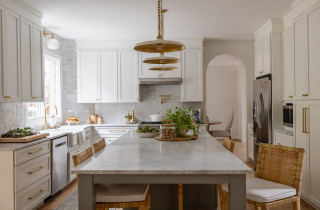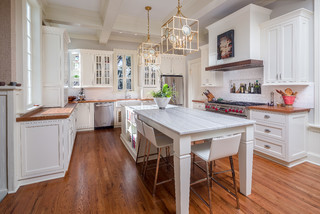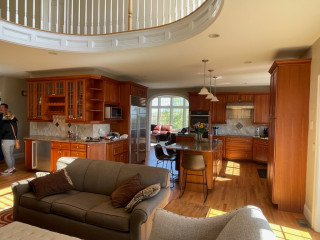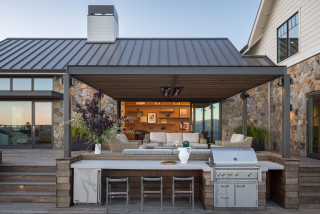
This article was originally published by a www.houzz.com . Read the Original article here. .

This article was originally published by a www.houzz.com . Read the Original article here. .

Specific kitchen designers’ services vary, but generally these professionals guide the homeowner through the kitchen design process, from initial consultation to installation. Not every upgrade necessarily calls for a kitchen designer. Paula Greer, senior designer at Bilotta Kitchen & Home in New York, says an interior designer or other design pro can help with minor changes such as replacing a countertop or backsplash. It’s when new cabinets and other big-picture elements come into play that a kitchen designer can really make life easier.
“A kitchen designer is going to have a background that other people — architects, interior designers — aren’t going to have because they specialize in kitchen cabinetry and the functionality of the kitchen cabinetry and how everything fits together,“ Greer says.
Kitchen designers also can help homeowners look at their kitchens with fresh eyes, suggesting new layouts, appliance configurations and room plans the homeowner may not have considered. Kitchen designers typically are familiar with the latest products and trends, can recommend (and potentially later manage) reputable subcontractors and suppliers and often can even help with details such as product warranties, Jennifer Gilmer of Jennifer Gilmer Kitchen & Bath and the author of kitchen design book The Kitchen Bible, says.
While investing in an independent kitchen designer’s services instead of going it alone or working with a customer rep at a big-box store can be pricier, a good kitchen designer also will be well versed in spending where it counts and making your dollars go further.
“Regardless of who designs the kitchen, it’s an expensive undertaking,” Gilmer says. “If a client is going to spend the money to remodel the kitchen, then using a kitchen designer will ensure that it’s done as well as possible, both in form and function.”
Find a kitchen designer near you
This article was originally published by a www.houzz.com . Read the Original article here. .

A good estimate on the total cost, properly divided into each stage, is imperative for this plan to work.
If your plan is simple and includes new appliances, new paint and some new hardware, then the estimate will be easy. Go to an appliance store or go online and price out the appliances. Get that painting bid for your cabinets and walls. Count up the hardware requirements, price out your selection, and there you have it. Three simple stages and not much risk (as long as you confirm your appliance selections fit their respective spaces — more on that later).
In larger, more complex jobs, though, it’s difficult to properly price things out without some experience, as kitchen remodels can potentially involve framers, finish carpenters, drywallers, electricians, plumbers, tile setters, slab fabricators, painters and possibly even foundation contractors, roofers, insulators and more.
The point is that it can be challenging to properly estimate a phased remodel, or any remodel, but you need to have a go at it and keep refining and updating as needed. Contractors are experienced at the task, but if you are estimating on your own, make sure you get bids for every subcontractor task and price out the fixtures and materials. And, if you can, try to get some consultation from someone with experience.
This article was originally published by a www.houzz.com . Read the Original article here. .

You don’t always have to go with an all-plywood construction. Thermofoil and laminate are both excellent budget-friendly options.
Thermofoil is a type of plastic finish applied to a medium-density fiberboard or other type of engineered wood core. It’s durable and easy to clean, and costs significantly less than wood. Laminate is likewise much less expensive than wood. It generally holds up well over time, though it isn’t as strong as wood. It’s more susceptible to moisture as well.
There are a few considerations to make if you decide to buy thermofoil or laminate cabinets. You will need to place delamination heat shields near your range. You may also want an all-plywood sink base or a sink mat for extra protection against moisture.
As a bonus, you can use the extra savings from laminate and thermofoil to add details to your cabinetry, including crown molding, corbels and a decorative door style.
This article was originally published by a www.houzz.com . Read the Original article here. .

When planning your remodel, make sure you put your kitchen’s busiest areas — the sink, stove and fridge — in practical locations that are relevant to one another while allowing enough space for people to use and access them comfortably, Findlay says.
When choosing cabinetry, make sure the doors won’t block your workflow when they’re open, she says. “The last thing you want is your fridge and cupboard doors banging into each other every time you open them!”
Solution: Plan your kitchen layout as far in advance as possible, and choose your appliances before you start looking at cabinetry, Findlay says. “This will allow you to fit your units around your appliances, rather than the other way around, giving you a seamless look that’s both smart and space-efficient.”
Tip: Think about how many people live in your home and will be using the kitchen at one time, she says. If it’s going to get crowded, you may have crammed too many elements into the kitchen layout and may want to consider scaling back.
This article was originally published by a www.houzz.com . Read the Original article here. .

For help, they hired designer Jackie Friberg of Granite State Cabinetry and interior planner Shayne Mitchell of Orchard Hill Interiors. Now, perimeter cabinetry in a pale gray-blue adds sophisticated and soothing style. A new one-level streamlined island in natural black walnut visually warms the space and provides enough seating for the whole family. Concrete-look perimeter countertops and a quartzite island countertop add interest. Painted nickel-gap paneling and a classic open plate rack cabinet bring charming touches. Updated appliances and a revamped bar area enhance function.
This article was originally published by a www.houzz.com . Read the Original article here. .

The existing kitchen was generously sized but had a lot of wasted space. For the new layout, Barber considered things like improving the traffic flow between rooms, accommodating gatherings and creating a way for the young children who live here to grab drinks and snacks in a spot outside the work triangle. She aimed to blend modern conveniences with traditional elements, and she did so skillfully, giving the kitchen what she calls “mood and soul.”
This article was originally published by a www.houzz.com . Read the Original article here. .

The existing kitchen was generously sized but had a lot of wasted space. For the new layout, Barber considered things like improving the traffic flow between rooms, accommodating gatherings and creating a way for the young children who live here to grab drinks and snacks in a spot outside the work triangle. She aimed to blend modern conveniences with traditional elements, and she did so skillfully, giving the kitchen what she calls “mood and soul.”
This article was originally published by a www.houzz.com . Read the Original article here. .

But after living with the kitchen for a number of years, they felt that while many of the elements looked and functioned fine, the bright white cabinets and blue island base dated the space. Seeking more warmth and a current look, they teamed up with designer Kerry Gillette, who used Houzz Pro software, for a refresh.
Now creamy white cabinets and a soft beige paint on the island base create a warm and inviting style. New rustic wood ceiling beams and wood-look flooring add more warmth. The flooring material and stools upholstered in performance fabric introduce durable details that stand up to frequent guests.
This article was originally published by a www.houzz.com . Read the Original article here. .

Counters help define your outdoor kitchen’s style. “Choose a stone [or other material] that ties the whole look together or provides a fun accent,” says Kara Gorski of Landed in Alexandria, Virginia.
Practical considerations. Add plenty of countertop area around the grill. “No matter how small an outdoor kitchen is, it needs to have adequate counter space,” says landscape designer Deborah Gliksman of Urban Oasis Landscape Design in Los Angeles. Douglass recommends leaving enough room for utensils as well as your cooked and uncooked food.
New York-based landscape designer Todd Haiman says you’ll probably need to seal the countertop when it’s installed and then reseal it every few years. “Fats from cooking as well as staining from metals left on top of it can stain it, and the elements can take their toll,” he says.
Finally, make good use of the cabinetry the counters sit on. It’s a prime space for storage as well as other amenities, such as an undercounter refrigerator.
Find a landscape contractor near you on Houzz
This article was originally published by a www.houzz.com . Read the Original article here. .
Mediterranean-style kitchens emphasize natural materials such as wood, brick and stone for a casually elegant, earthy look inspired by sun and sea. While traditionally Mediterranean kitchens have featured warm hues and heavy wrought iron details, today’s iterations often take a lighter approach, with plenty of white space to offset the rich tilework and natural wood.
Key features of Mediterranean-style kitchens:
Dark, rich wood, such as walnutMaterials with patina, such as brick, stone and reclaimed wood
Colorful tileCurving arch detailsLighting made from wrought iron, hammered metals and reclaimed woodNatural fiber and leather accents
Color palette: Rich hues inspired by the warm earth and sparkling sea — such as chile pepper, terra cotta and cerulean blue — look striking in a Mediterranean kitchen, especially against a calming backdrop of white and natural wood.
Your Guide to a Mediterranean-Style Kitchen